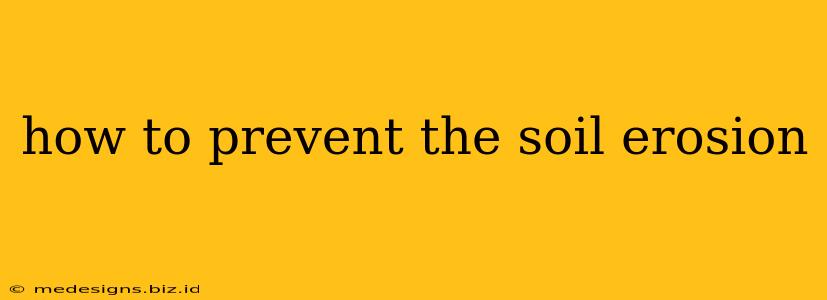Soil erosion is a significant environmental problem, leading to land degradation, water pollution, and loss of fertile topsoil. Understanding how to prevent soil erosion is crucial for maintaining healthy ecosystems and ensuring food security. This comprehensive guide explores effective methods to combat this issue, from simple home practices to large-scale land management techniques.
Understanding the Causes of Soil Erosion
Before diving into prevention methods, it's essential to understand what causes soil erosion. The primary culprits are:
- Water Erosion: Rainfall and runoff are major contributors. Heavy downpours detach soil particles, carrying them away downstream. This is especially problematic on slopes.
- Wind Erosion: Strong winds, particularly in dry areas, can lift and transport topsoil, leaving behind barren land. This is exacerbated by lack of vegetation cover.
- Human Activities: Deforestation, unsustainable agricultural practices (like overgrazing and tilling), and construction all significantly accelerate soil erosion rates.
Effective Strategies to Prevent Soil Erosion
Preventing soil erosion requires a multi-pronged approach, incorporating both natural and human interventions. Here are some key strategies:
1. Planting Vegetation: Nature's Shield
Trees, shrubs, and grasses are nature's best defense against erosion. Their roots bind the soil together, reducing its susceptibility to wind and water. Consider:
- Cover Crops: Planting crops like clover or rye between cash crops helps protect the soil during fallow periods.
- Windbreaks: Strategic planting of trees and shrubs can break the force of the wind, reducing its erosive power. This is particularly effective in windy regions.
- Reforestation: Replanting trees in deforested areas is crucial for long-term soil stabilization.
2. Contour Farming: Following the Land
Contour farming involves plowing and planting along the contours of the slope, creating a series of level terraces. This slows down water runoff, reducing its erosive impact.
3. Terracing: Creating Level Steps
Terracing is the creation of a series of level platforms cut into a slope. This significantly reduces the slope's gradient, minimizing water erosion. Terracing is particularly useful on steep hillsides.
4. No-Till Farming: Leaving the Soil Undisturbed
No-till farming avoids plowing the soil, preserving its structure and minimizing erosion. This method also improves soil health and reduces water runoff.
5. Crop Rotation: Diversifying Your Approach
Crop rotation involves planting different crops in succession. This helps to improve soil health, reduce pest and disease problems, and increase soil stability.
6. Mulching: Protecting the Soil Surface
Mulching involves covering the soil surface with organic materials like straw, wood chips, or compost. This protects the soil from rain impact and reduces evaporation.
7. Grazing Management: Controlled Grazing for Healthy Pastures
Sustainable grazing practices, such as rotational grazing and controlled stocking rates, prevent overgrazing, allowing vegetation to recover and protect the soil.
8. Water Management: Efficient Irrigation Techniques
Efficient irrigation techniques, such as drip irrigation, minimize water runoff and soil erosion associated with traditional irrigation methods.
9. Erosion Control Structures: Engineering Solutions
In areas with significant erosion problems, engineering solutions such as check dams, sediment basins, and gabions can help to control water flow and trap sediment.
Conclusion: A Collaborative Effort
Preventing soil erosion requires a concerted effort from individuals, farmers, and governments. By implementing these preventative measures, we can protect our valuable topsoil, ensuring a healthy environment and sustainable future. Remember, small changes can make a big difference in preserving our precious land for generations to come. Start by understanding your local environment and choosing the methods most appropriate for your area.
